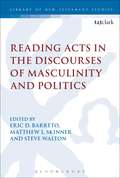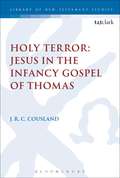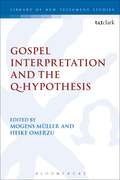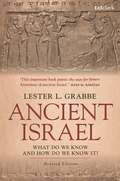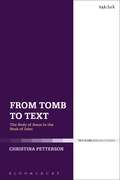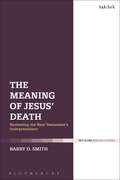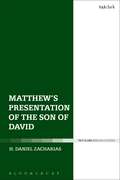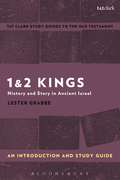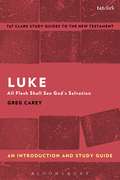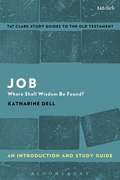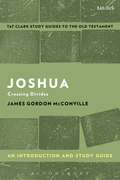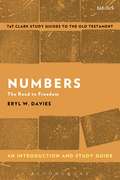- Table View
- List View
Reading Acts in the Discourses of Masculinity and Politics (The Library of New Testament Studies #559)
by Eric Barreto Matthew L. Skinner Steve WaltonThis book looks at the Acts of the Apostles through two lenses that highlight the two topics of masculinity and politics. Acts is rich in relevant material, whether this be in the range of such characters as the Ethiopian eunuch, Cornelius, Peter and Paul, or in situations such as Timothy's circumcision and Paul's encounters with Roman rulers in different cities. Engaging Acts from these two distinct but related perspectives illuminates features of this book which are otherwise easily missed. These approaches provide fresh angles to see how men, masculinity, and imperial loyalty were understood, experienced, and constructed in the ancient world and in earliest Christianity. The essays present a range of topics: some engage with Acts as a whole as in Steve Walton's chapter on the way Luke-Acts perceives the Roman Empire, while others focus on particular sections, passages, and even certain figures, such as in an Christopher Stroup's analysis of the circumcision of Timothy. Together, the essays provide a tightly woven and deeply textured analysis of Acts. The dialogue form of essay and response will encourage readers to develop their own critiques of the points raised in the collection as a whole.
Holy Terror: Jesus in the Infancy Gospel of Thomas (The Library of New Testament Studies #560)
by J.R.C. CouslandThe Infancy Gospel of Thomas (or Paidika) is one of the most unusual gospels in the Christian tradition. Instead of revealing the compassionate Jesus so familiar to us from the biblical Gospels, it confronts its readers with a very different Jesus – a child who sometimes acts like a holy terror, killing and harming others for trifling faults. So why is Jesus portrayed as acting in such an 'unchristian' fashion? To address this question, Cousland focuses on three interconnected representations of Jesus in the Paidika: Jesus as holy terror, as child, and as miracle-working saviour. Cousland endeavours to show that, despite the differing character of these three roles, they present a unified picture. Jesus' unusual behaviour arises from his 'growing pains' as a developing child, who is at the same time both human and divine. Cousland's volume is the first detailed examination of the Christology of the Infancy Gospel of Thomas and provides a fresh and engaging approach to a topic not often discussed in representations of Jesus.
Judas Iscariot: A Critical Examination of the Portrayal of Judas in Jesus Films (1902-2014) (Scriptural Traces)
by Carol A. HebronAt the beginning of the 20th century, Judas was characterised in film as the epitome of evil: the villainous Jew. Film-makers cast Judas in this way because this was the Judas that audiences had come to recognize and even expect. But in the following three decades, film-makers - as a result of critical biblical study - were more circumspect about accepting the alleged historicity of the Gospel accounts. Carol A. Hebron examines the figure of Judas across film history to show how the portrayal becomes more nuanced and more significant, even to the point where Judas becomes the protagonist with a role in the film equal in importance to that of Jesus'. Hebron examines how, in these films, we begin to see a rehabilitation of the Judas character and a restoration of Judaism. Hebron reveals two distinct theologies: 'rejection' and 'acceptance'. The Nazi Holocaust and the exposure of the horrors of genocide at the end of World War II influenced how Judaism, Jews, and Judas, were to be portrayed in film. Rehabilitating the Judas character and the Jews was necessary, and film was deemed an appropriate medium in which to begin that process.
Women and Exilic Identity in the Hebrew Bible: Conceptualizations Of Women During And After The Exile (The Library of Hebrew Bible/Old Testament Studies #631)
by Martien A. Halvorson-Taylor Katherine E. SouthwoodNotions of women as found in the Bible have had an incalculable impact on western cultures, influencing perspectives on marriage, kinship, legal practice, political status, and general attitudes. Women and Exilic Identity in the Hebrew Bible is drawn from three separate strands to address and analyse this phenomenon. The first examines how women were conceptualized and represented during the exilic period. The second focuses on methodological possibilities and drawbacks connected to investigating women and exile. The third reviews current prominent literature on the topic, with responses from authors. With chapters from a range of contributors, topics move from an analysis of Ruth as a woman returning to her homeland, and issues concerning the foreign presence who brings foreign family members into the midst of a community, and how this is dealt with, through the intermarriage crisis portrayed in Ezra 9-10, to an analysis of Judean constructions of gender in the exilic and early post-exilic periods. The contributions show an exciting range of the best scholarship on women and foreign identities, with important consequences for how the foreign/known is perceived, and what that has meant for women through the centuries.
The Formation of the Biblical Canon: The Old Testament: Its Authority and Canonicity
by Lee Martin McDonaldLee Martin McDonald provides a magisterial overview of the development of the biblical canon --- the emergence of the list of individual texts that constitutes the Christian bible. In these two volumes -- in sum more than double the length of his previous works -- McDonald presents his most in-depth overview to date. McDonald shows students and researchers how the list of texts that constitute 'the bible' was once far more fluid than it is today and guides readers through the minefield of different texts, different versions, and the different lists of texts considered 'canonical' that abounded in antiquity. Questions of the origin and transmission of texts are introduced as well as consideration of innovations in the presentation of texts, collections of documents, archaeological finds and Church councils.In this first volume McDonald reexamines issues of canon formation once considered settled, and sets the range of texts that make up the Hebrew Bible (or Old Testament) in their broader context. Each indidvidual text is discussed, as are the cultural, political and historical situations surrounding them.The second volume considers the New Testament, and the range of so-called 'apocryphal' gospels that were written in early centuries, and used by many Christian groups before the canon was closed. Also included are comprehensive appendices which show various canon lists for both Old and New Testaments and for the bible as a whole.
The Formation of the Biblical Canon: The New Testament: Its Authority and Canonicity
by Lee Martin McDonaldLee Martin McDonald provides a magisterial overview of the development of the biblical canon --- the emergence of the list of individual texts that constitutes the Christian bible. In these two volumes -- in sum more than double the length of his previous works -- McDonald presents his most in-depth overview to date. McDonald shows students and researchers how the list of texts that constitute 'the bible' was once far more fluid than it is today and guides readers through the minefield of different texts, different versions, and the different lists of texts considered 'canonical' that abounded in antiquity. Questions of the origin and transmission of texts are introduced as well as consideration of innovations in the presentation of texts, collections of documents, archaeological finds and Church councils.In the first volume McDonald reexamines issues of canon formation once considered settled, and sets the range of texts that make up the Hebrew Bible (or Old Testament) in their broader context. Each indidvidual text is discussed, as are the cultural, political and historical situations surrounding them.This second volume considers the New Testament, and the range of so-called 'apocryphal' gospels that were written in early centuries, and used by many Christian groups before the canon was closed. Also included are comprehensive appendices which show various canon lists for both Old and New Testaments and for the bible as a whole.
A History of the Hasmonean State: Josephus and Beyond (Jewish and Christian Texts)
by Kenneth AtkinsonKenneth Atkinson tells the exciting story of the nine decades of the Hasmonean rule of Judea (152 - 63 BCE) by going beyond the accounts of the Hasmoneans in Josephus in order to bring together new evidence to reconstruct how the Hasmonean family transformed their kingdom into a state that lasted until the arrival of the Romans. Atkinson reconstructs the relationships between the Hasmonean state and the rulers of the Seleucid and the Ptolemaic Empires, the Itureans, the Nabateans, the Parthians, the Armenians, the Cappadocians, and the Roman Republic. He draws on a variety of previously unused sources, including papyrological documentation, inscriptions, archaeological evidence, numismatics, Dead Sea Scrolls, pseudepigrapha, and textual sources from the Hellenistic to the Byzantine periods.Atkinson also explores how Josephus's political and social situation in Flavian Rome affected his accounts of the Hasmoneans and why any study of the Hasmonean state must go beyond Josephus to gain a full appreciation of this unique historical period that shaped Second Temple Judaism, and created the conditions for the rise of the Herodian dynasty and the emergence of Christianity.
The Future of Higher Education in the Middle East and Africa: QS Middle East and North Africa Professional Leaders in Education Conference
by Habib M. Fardoun Kevin J. Downing Mandy MokThis book addresses some of the challenges posed by the globalization of higher education. It examines the emergence and resulting challenges of English as Lingua Franca (ELF) and of the decision to use English as the Medium of Instruction (EMI) as part of a strategic policy of internationalization. It looks at survival challenges caused by globalization and expansion, the diversity challenge, the concept of marginality and how marginality can lead to creativity, teaching and encouraging entrepreneurialism, the tools needed for internationalizing higher education in developing countries, innovative approaches, the intelligent use of technology, and finally, the value of non-constraint engagement in driving teaching and course quality improvements. The expansion of higher education and the increasingly international body of students and staff continue to inspire and drive the development of global higher education systems. Whilst these systems began locally, many are now engaging with the challenges of retaining their local flavour whilst embracing the march of globalisation. The challenge is to find local solutions that also meet the requirements of the rapid development of what might be termed the ‘massification’ of international higher education. This book reflects these contemporary challenges through its variety of topics taken from countries as diverse as Hong Kong, Panama, South Africa, USA and Saudi Arabia. The topics are as diverse as some of the local solutions but each chapter represents a response to a rapidly changing global landscape.
Paul's Large Letters: Paul's Autographic Subscription in the Light of Ancient Epistolary Conventions (The Library of New Testament Studies #561)
by Steve ReeceAt the end of several of his letters the apostle Paul claims to be penning a summary and farewell greeting in his own hand: 1 Corinthians, Galatians, Philemon, cf. Colossians, 2 Thessalonians. Paul's claims raise some interesting questions about his letter-writing practices. Did he write any complete letters himself, or did he always dictate to a scribe? How much did his scribes contribute to the composition of his letters? Did Paul make the effort to proofread and correct what he had dictated? What was the purpose of Paul's autographic subscriptions? What was Paul's purpose in calling attention to their autographic nature? Why did Paul write in large letters in the subscription of his letter to the Galatians? Why did he call attention to this peculiarity of his handwriting?A good source of answers to these questions can be found among the primary documents that have survived from around the time of Paul, a large number of which have been discovered over the past two centuries and in fact continue to be discovered to this day. From around the time of Paul there are extant several dozen letters from the caves and refuges in the desert of eastern Judaea (in Hebrew, Aramaic, Nabataean, Greek, and Latin), several hundred from the remains of a Roman military camp in Vindolanda in northern England (in Latin), and several thousand from the sands of Middle and Upper Egypt (in Greek, Latin, and Egyptian Demotic). Reece has examined almost all these documents, many of them unpublished and rarely read, with special attention to their handwriting styles, in order to shed some light on these technical aspects of Paul's letter-writing conventions.
Colossians BNTC (Black's New Testament Commentaries)
by Paul FosterFoster provides the commentary on Colossians in this renowned series of biblical commentaries, under the General Editorship of Professor Morna D. Hooker (Lady Margaret Professor of Divinity Emerita in the University of Cambridge, UK). As with other volumes in the series, the key questions for scholars are scrutinised thoroughly - questions of historicity, the use of historical traditions and sources, the relationship of Colossians to the rest of the New Testament in particular the Pauline letters, authorship, and setting. Foster examines these issues in such a way as to present the heart of the academic debate to a wider audience, as befitting to the series reputation for rigorous commentary, which not only advances the knowledge of students and pastors, but also makes a contribution to the academic discourse in its own right.
Gospel Interpretation and the Q-Hypothesis (The Library of New Testament Studies)
by Mogens Müller Heike OmerzuThe Q-Hypothesis has functioned as a mainstay of study of the synoptic gospels for many years. Increasingly it comes under fire. In this volume leading proponents of Q, as well as of the case against Q, offer the latest arguments based on the latest research into this literary conundrum. The contributors to the volume include John Kloppenborg, Christopher Tuckett, Clare Rothschild, Mark Goodacre, and Francis Watson. The Q-Hypothesis is examined in depth and the discussion moves back and forth over Q's strengths and weaknesses. As such the volume sheds light on how the gospels were composed, and how we can view them in their final literary forms.
Spirit and Word: Dual Testimony in Paul, John and Luke (The Library of New Testament Studies #565)
by Timothy WiardaA number of New Testament passages depict the Holy Spirit acting in conjunction with gospel preaching or other forms of humanly given communication about Jesus, yet there is considerable disagreement about how these passages should be interpreted. Unresolved exegetical debates about the correlative action (the “dual testimony”) of the Spirit and the humanly conveyed word plague the interpretation of whole writings, extended sections of individual works, and important themes. This book examines this contested motif in a focused and comprehensive way. It begins by taking the Pauline, Johannine, and Lucan writings in turn, subjecting the central texts that express dual testimony to detailed exegetical analysis. On the basis of this exegetical work it then moves to a big-picture analysis of the way each corpus expresses and uses the dual-testimony motif, identifying individual emphases and tendencies as well as shared elements that can be observed across the three bodies of writing. Two final chapters offer brief reflections on possible developmental scenarios and points at which the preceding exegetical findings may impinge on questions of contemporary theology.
Ancient Israel: Revised Edition
by Lester L. GrabbeIn Ancient Israel Lester L. Grabbe sets out to summarize what we know through a survey of sources and how we know it by a discussion of methodology and by evaluating the evidence. The most basic question about the history of ancient Israel, how do we know what we know, leads to the fundamental questions of Grabbe's work: what are the sources for the history of Israel and how do we evaluate them? How do we make them 'speak' to us through the fog of centuries? Grabbe focuses on original sources, including inscriptions, papyri, and archaeology. He examines the problems involved in historical methodology and deals with the major issues surrounding the use of the biblical text when writing a history of this period. Ancient Israel provides an enlightening overview and critique of current scholarly debate. It can therefore serve as a 'handbook' or reference-point for those wanting a catalogue of original sources, scholarship, and secondary studies. Grabbe's clarity of style makes this book eminently accessible not only to students of biblical studies and ancient history but also to the interested lay reader. For this new edition the entire text has been reworked to take account of new archaeological discoveries and theories. There is a major expansion to include a comprehensive coverage of David and Solomon and more detailed information on specific kings of Israel throughout. Grabbe has also added material on the historicity of the Exodus, and provided a thorough update of the material on the later bronze age.
From Tomb to Text: The Body of Jesus in the Book of John
by Christina PettersonThe idea of writing plays a central role in John. Apart from the many references to scriptural texts, John emphasizes the role of writing in the inscription on the cross and in its own production. Petterson's From Tomb to Text examines what this means for the understanding of the Johannine Jesus in two interrelated ways. First Petterson takes these claims to revelation through writing seriously, noting the immense effort expended by biblical scholars in order to dismiss them and to produce a canonically palatable John. With few exceptions, Johannine studies have consistently attempted to domesticate or tame John's book through reference to, and in harmony with, an externalized historical reality or with a synoptic pattern. Second, the study suggests alternative ways of understanding John once this synoptic compulsion has been dissolved. Petterson argues that John's Jesus is unacceptable to the project for the recovery of 'Early Christianity' as imagined in Johannine research over the last 70 years or so. Instead, she shows how John produces itself as the vehicle of Jesus' revelation in place of a body. This takes place through its use of writing, its characteristic use of verbs and syntax, and its mode of revelation. The book thus situates John in a context that does not begin with, and thus attempts to be, unconstrained by fixed categories of Christ, gnosticism, Eucharist, body and flesh, and shows how such readings curtail the fullness of the text in favour of a more familiar earthly Jesus. Petterson concludes by outlining ways in which John can be read if these containment strategies are disregarded.
History, Politics and the Bible from the Iron Age to the Media Age (The Library of Hebrew Bible/Old Testament Studies #651)
by James G. Crossley Jim WestAs biblical studies becomes increasingly fragmented, this collection of essays brings together a number of leading scholars in order to show how historical reconstruction, philology, metacriticism, and reception history can be part of a collective vision for the future of the field. This collection of essays focuses more specifically on critical questions surrounding the construction of ancient Israel(s), 'minimalism', the ongoing significance of lexicography, the development of early Judaism, orientalism, and the use of the Bible in contemporary political discourses. Contributors include John van Seters, Niels Peter Lemche, Ingrid Hjelm, and Philip R. Davies.
The Meaning of Jesus' Death: Reviewing the New Testament’s Interpretations
by Barry D. SmithBarry D. Smith studies the salvation-historical meaning of Jesus' death (commonly known as the atonement) in the New Testament. Smith works his way through the four theories of the doctrine of the atonement that have emerged in the history of Christian theology: moral influence, governmental, satisfaction and Christus victor theories. Smith works from the premise that, for a theory of the atonement to be successful, no biblical data may be omitted or distorted, and the generalized concepts used to comprehend the biblical data must be easily seen as implicit in the data. From this vantage point, Smith advances a formulation of the atonement that is best supported by the biblical text itself. The conclusion Smith reaches is that the biblical data supports both the penal-substitutionary version of the satisfaction theory and the Christus victor theory of the atonement, each of which should be viewed as two parts of a more inclusive theory of atonement present in the New Testament.
Coins as Cultural Texts in the World of the New Testament
by David H. WenkelCoins have long been a vital part of the discipline of classical studies of the ancient world. However, many scholars have commented that coins have not been adequately integrated into the study of the New Testament. This book provides an interdisciplinary gateway to the study of numismatics for those who are engaged in biblical studies. Wenkel argues that coins from the 1st century were cultural texts with communicative power. He establishes a simple yet comprehensive hermeneutic that defines coins as cultural texts and explains how they might be interpreted today. Once coins are understood to be cultural texts, Wenkel proceeds to explain how these texts can be approached from three angles. First, the world in front of the coin is defined as the audience who initially read and responded to coins as cultural texts. The entire Roman Empire used coins for payment. Second, the world of the coin refers to the coin itself – the combination of inscriptions and images. This combination of inscription and image was used ubiquitously as a tool of propaganda. Third, the world behind the coin refers to the world of power and production behind the coins. This third angle explores the concept of authorship of coins as cultural texts.
Matthew’s Presentation of the Son of David
by H. Daniel ZachariasH. Daniel Zacharias presents a literary-critical analysis of the Gospel of Matthew and its interaction with Davidic tradition and use of Davidic typology. Throughout the narrative, the evangelist makes pervasive use of Davidic tradition from the Old Testament in his portrayal of Jesus. This begins from the first verse and the declaration that Jesus is the Son of David, and culminates in Jesus' usage of Psalm 22's Davidic lament on the cross. Davidic material is present throughout Matthew, in allusion, in specific citations, in thematic material. In addition, Matthew makes use of Davidic typology numerous times, with David as type and Jesus as anti-type. Zacharias shows how the use of Davidic material presents to the reader a scripturally-grounded redefinition of what it means for Jesus to be the Son of David: not as a violent militant leader, as some expected, but as a physical descendant of David, a healing shepherd, and a humble king. Within the Gospel, Matthew utilizes Davidic typology to show how the Son of David even has similar experiences as his royal predecessor. Even David's own words from the psalms are utilized as testimony to the legitimacy of Jesus as the Davidic Messiah.
1 & 2 Kings: History and Story in Ancient Israel (T&T Clark’s Study Guides to the Old Testament)
by Lester L. GrabbeLester L. Grabbe provides a concise and up-to-date introduction to the books of Kings, covering all the historical and interpretative issues. Grabbe pays particular attention to how the history of ancient Israel can be reconstructed (or not as the case may be) through the text, and introduces students to the key ways of reading the books of Kings as religious and political history.Grabbe takes a chronological approach (according to the text) and provides overviews of the key periods of Israel's history. The nature of the 'Deuteronomistic History' and how well this theory of authorship stands up in the modern day is considered, as well as issues of form and source criticism more broadly. Grabbe concludes by offering a reflection on the books of Kings in theological and hermeneutical perspective, which enables students to view not only the historical and textual issues, but also broader issues of meaning and significance.
Luke: All Flesh Shall See God's Salvation (T&T Clark’s Study Guides to the New Testament)
by Greg CareyGreg Carey's guide equips readers to develop their own informed assessments of Luke's Gospel. The book begins with an inductive exposition of Luke's singular approach to composing a story about Jesus, examining its use of Mark, clues to its social setting, and its distinctive literary strategies. Recognizing that many readers approach Luke for theological and religious reasons, while many others do not, a chapter on 'Spirit' addresses Luke's presentation of the God of Israel, how the Gospel ties salvation to the person of Jesus, and how the problems of sin and evil find their resolution in the kingdom of God and in community of those who follow Jesus. A chapter on 'Practice' examines the Gospel's vision for human community. While many readers find a revolutionary message in which women, the poor, Gentiles and sinners find themselves included and blessed in Luke's Gospel, this volume calls attention to inconsistencies and tensions within the narrative. Luke does speak toward inclusion, Carey argues, but not in a revolutionary way. Could it be that the Gospel promises more than it delivers? Carey suggests that Luke speaks to people of relative privilege, challenging them toward mercy and inclusion rather than toward fundamental social change. An Epilogue reflects upon contemporary readers of Luke, most of whom enjoy privilege in their own right, and how they may respond to Luke's story.
Job: Where Shall Wisdom Be Found? (T&T Clark’s Study Guides to the Old Testament)
by Katharine J. DellIn the light of dramatic new interpretative approaches to the Bible this guide to Job follows not only a range of new approaches to the text but also addresses the traditional historical questions and other topical issues. Dell particularly highlights the problem of genre in understanding Job. She shows how problematic the term 'wisdom' is for this unique book, and argues that its radical sentiments earn it, rather, the title of 'parody'. Of all the biblical books it comes closest to tragedy, raising profound questions about its nature and place in the biblical canon.Job's relationship to its ancient Near Eastern counterparts, notably in ancient Mesopotamia, are also closely examined and key theological themes that characterize the book are explored. Finally different approaches - feminist, liberationist, ecological and psychological - are outlined so as to illuminate and inform our own personal readings and generate ever fresh understandings of this enigmatic text.
Joshua: Crossing Divides (T&T Clark’s Study Guides to the Old Testament)
by James Gordon McConvilleThe book of Joshua, with its memorable images of the crossing of the River Jordan and the miraculous conquest of the city of Jericho, plays an important part in the Old Testament's narrative and theology of God's promise and gift of the land of Canaan to Israel.In this guide, Gordon McConville considers the various aspects of interpreting Joshua, including questions of its origins and occasion, its literary formation and its theology. He also looks squarely at the difficulties it poses to the modern reader, and the dangers of simplistic interpretations, especially when allied with power systems. Yet, among the possible approaches to Joshua, certain readings suggest unexpected messages, and with the book's memorable central image of crossing a river in an escape from tyranny into new life, it can prompt fruitful reflection on other 'crossings', perhaps helping us to overcome the deepest human hostilities.
Numbers: The Road to Freedom (T&T Clark’s Study Guides to the Old Testament)
by Eryl W. DaviesDavies outlines the composition and date of Numbers, and the various attempts that have been made to establish a coherent and meaningful structure in its arrangement. Davies also shows how the application of reader-response criticism, feminist criticism and postcolonial criticism have contributed to our understanding of selected passages in the book. Addressing theological issues, Davies considers three themes that occupy much of the content of Numbers, namely; land, purity and holiness, and rebellion. The concluding chapter considers the contentious issue of the historicity of the book of Numbers in the light of recent discussions concerning the historical value of the Old Testament. Davies shows how some of the issues Numbers raises – war, disease, survival, hunger, race relations – are among the perennial problems faced by nations across the centuries and across cultures. While individual passages within Numbers may reflect a questionable sense of morality, Davies demonstrates that the book, when viewed in its totality, encompasses a number of important theological themes which recur throughout the Old Testament: the interplay of forgiveness and judgment, and of sin and punishment, and the need to trust in the power of God rather than human might.
Handbook of Rural School Mental Health
by Kurt D. Michael John Paul JamesonThis handbook offers a comprehensive overview of school mental health (SMH) initiatives in rural areas in the United States. It offers clinical and administrative guidelines for innovative and effective programs addressing critical problems among rural youth and in areas where funding and resources are scarce. Chapters cover program development, implementation, sustainability, and evaluation; consider issues of community and policy support; address barriers to access and delivery; and debunk misconceptions about the region and its cultures. Chapters also discuss rural SMH applications relating to special populations, including students with autism, depression, anxiety, bipolar disorder, conduct disorders, and ADHD. In addition, the book examines the potential of school-based programs as a counter to the stigma and distrust of mental health services common to the region.Topics featured in the Handbook include:The value of rural SMH from an educator’s standpoint. Preventing suicide among students in rural schools. Substance abuse in rural school settings. Bullying and cyberbully among rural youth. Intergenerational patterns of mental illness in rural settings and their relevance for SMH.The importance of involving communities in culturally competent rural interventions.The Handbook of Rural School Mental Health is a must-have resource for researchers, scientist-practitioners, and graduate students in child and school psychology, educational psychology, social work/counseling, educational policymakers, pediatrics/school nursing, teaching, and teacher education.
Food Ethics Education (Integrating Food Science and Engineering Knowledge Into the Food Chain #13)
by Rui Costa Paola PittiaThe book is divided in 3 sections, each containing several chapters: Section 1 includes chapters that identify and discuss several ethical issues along the food chain, with particular detail of issues in the food industry and in consumer behavior; Section 2 includes chapters that present the basis of a code of conduct in the food profession as well as the description of existing codes of conduct of food industry and food scientist professionals, including ethics of publishing, and also ethics in risk communication; Section 3 includes chapters based on case studies with examples of teaching approaches currently used in teaching food ethics, easy to implement and already tested and confirmed as successful examples that engage students in this topic.Although professional ethics in food supply chain is claimed as an essential topic to be addressed in any degree program, few higher education institutions that currently include a module on ethics in their study programs. In general, it is argued that ethics is a topic addressed along the curriculum and embedded in the contents of the modules. However, ethics, for its importance, needs a different teaching and educational approach, and this book achieves that..
